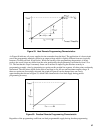
91
OUTPUT VOLTAGE AND CURRENT RATINGS
DUTY CYCLE LOADING
In some applications the load current varies periodically from a minimum to a maximum value. At first it might
seem that a regulated power supply having a current rating in excess of the average load requirement (but less
than the peak load value) would be adequate for such applications. However, the current limit or constant
current circuit within a semiconductor power supply limits the output current on an instantaneous not an
average basis, because extremely rapid protection is necessary to provide adequate safeguard against burnout of
the regulating elements.
The first question which must be answered when powering a dc load that draws a large current during some
portion of its operating cycle is whether (1) the power supply need only withstand the peak load condition, or
whether (2) the power supply must continue to deliver its full value of regulated output voltage during the peak
load interval.
Examples of the first category are dc motors and filaments for large vacuum tubes. While the starting resistance
of these loads is very low compared to the normal operating value, it is not necessary that the power supply be
able to deliver this peak current--it is necessary that the supply withstand without damage this initial peak load
condition and that it continue to operate through the peak load interval until normal load conditions are
established. For such loads Constant Voltage/Constant Current or Constant Voltage/Current Limiting supplies
rated for the normal (not the peak) load condition are adequate and, in some cases preferable, since the limited
output current can provide protection for the load device during the peak load interval. Peak load demands in
excess of the current rating of the power supply will not result in damage to the power supply; the output
voltage will merely drop to a slightly lower value. Normal output voltage will be restored automatically by the
power supply after the peak or transient load condition has passed.
As for the second category, if it is desired to meet a duty cycle requirement similar to that illustrated in Figure
63 while retaining the full value of regulated output voltage during peak load conditions, then a power supply
must be selected which has a current rating equal to or greater than the peak load requirement. However, if the
peak load condition is of relatively short duration, then the stored energy in the power supply output capacitor
may prevent an excessive output voltage sag.
Thus for peak loads of either category (1) or (2), it is of interest to know how much the output voltage will drop
for a peak load condition in excess of the power supply current rating, and how long it will take for the supply
to recover to its normal output voltage following the removal of the overload. Figure 63 illustrates the
equivalent circuit and output voltage waveform which are characteristic of a power supply experiencing a short
term overload. When the overload condition is first imposed, the power supply goes into the current limit mode
and is, therefore, equivalent to a constant current generator I
L
feeding the output capacitor Co (already charged
to E
NORM
) in parallel with the lowered value of load resistance R
L
PEAK
. Thus the capacitor begins discharging
exponentially toward the final output voltage value which would result if the overload condition were retained,
namely I
L
R
L
PEAK
. The amount of voltage sag ∆V depends upon the output time constant and the duration of the
overload peak load condition; the equation for this voltage sag is given in Figure 63. When the peak load
condition is removed, R
L
is restored to its normal value and the supply continues in the current limiting mode,
charging the output capacitor on another exponential curve. This time the asymptotic level approached by the
exponential curve is I
L
R
L
NORM
. However, this charging action stops when the voltage level has risen to the
normal level, and the regulator changes from the current limit mode to the normal constant voltage mode.
Figure 63 also gives the equation for the time required for this voltage recovery following the removal of the


















